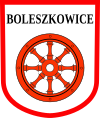 Alternate name: Fürstenfelde [Ger]. 52°43' N 14°34' E, 272.3 miles W of Warszawa. Boleszkowice (formerly German Fürstenfelde) is a village in Myślibórz County, West Pomeranian Voivodeship. Before 1945 the area was part of Germany /Pomerania. The village has a population of 1,316. Gmina Boleszkowice is a rural gmina (administrative district) in Myślibórz County, West Pomeranian Voivodeship, in NW Poland, on the German border. Its seat is the village of Boleszkowice, which lis approximately 20 mi SW of Myślibórz and 48 mi S of the regional capital Szczecin. The gmina 2006 total population was 2,899. Gmina Boleszkowice contains the villages and settlements of Boleszkowice, Chlewice, Chwarszczany, Gudzisz, Kaleńsko, Namyślin, Porzecze, Reczyce, Wielopole, Wierutno, Wysoka and Wyszyna. [April 2009]
Alternate name: Fürstenfelde [Ger]. 52°43' N 14°34' E, 272.3 miles W of Warszawa. Boleszkowice (formerly German Fürstenfelde) is a village in Myślibórz County, West Pomeranian Voivodeship. Before 1945 the area was part of Germany /Pomerania. The village has a population of 1,316. Gmina Boleszkowice is a rural gmina (administrative district) in Myślibórz County, West Pomeranian Voivodeship, in NW Poland, on the German border. Its seat is the village of Boleszkowice, which lis approximately 20 mi SW of Myślibórz and 48 mi S of the regional capital Szczecin. The gmina 2006 total population was 2,899. Gmina Boleszkowice contains the villages and settlements of Boleszkowice, Chlewice, Chwarszczany, Gudzisz, Kaleńsko, Namyślin, Porzecze, Reczyce, Wielopole, Wierutno, Wysoka and Wyszyna. [April 2009]
CEMETERY: The Jewish cemetery established in the 19th century is next to the road from Boleszkowice to Namyslin. Fenced with a wall, only four gravestones remain. [April 2009]
US Comm.No. POCE000338
- Boleszkowice is in Gorzow Wielkopolski region at 52°43 N / 14°34 E, 10 km from Debno. The cemetery is SE on the road to Namyslina. Present population is 1,000-5,000 with no Jews.
- Town: Urzad Gminy W Boleszkowicach. Mgr. Wkadyslaw Chrostowski, Wojewodzki Konserwator Zabytkow, 66-413 Gorzow Wikp ulica Jagiellonczyka 8, tel. 75-295.
- Regional: Panstwowa Skuzba Ochrony Zabutkow, Oddzine w Gorzowie Wlup, mgr. Jwona Drzewiecka, adres J.W.
- Interested: Urzad Gminy W Boleszuswicach, Nadlesnictwo Debno.
This Progressive/Reform cemetery was established at the beginning of the 19th century. The isolated, wooded flat, rural has no sign or marker. Reached by turning directly off a private road, access is open to all via a broken masonry wall with no gate. The cemetery before WWII and now is 0.08 ha. 1 to 20 stones are visible in original location with less than 25% toppled or broken. Vegetation overgrowth is a constant problem, disturbing graves. The 1853 through 19th century sandstone, flat with carved relief decoration or finely smoothed stones have Hebrew and German inscriptions. The Forest District Administration of Debno and the municipality own and use site as a Jewish cemetery. Adjacent property is forest. Rarely, local residents visit. The cemetery was vandalized during WWII with no care now. Weather erosion, vegetation, and vandalism are moderate threats.
Henyk Grecki, tel 377-47, 70-534 Szuecin, ul Sottysia 3/13 completed survey on August 14, 1991 but did not visit the site. Documentation: form.
